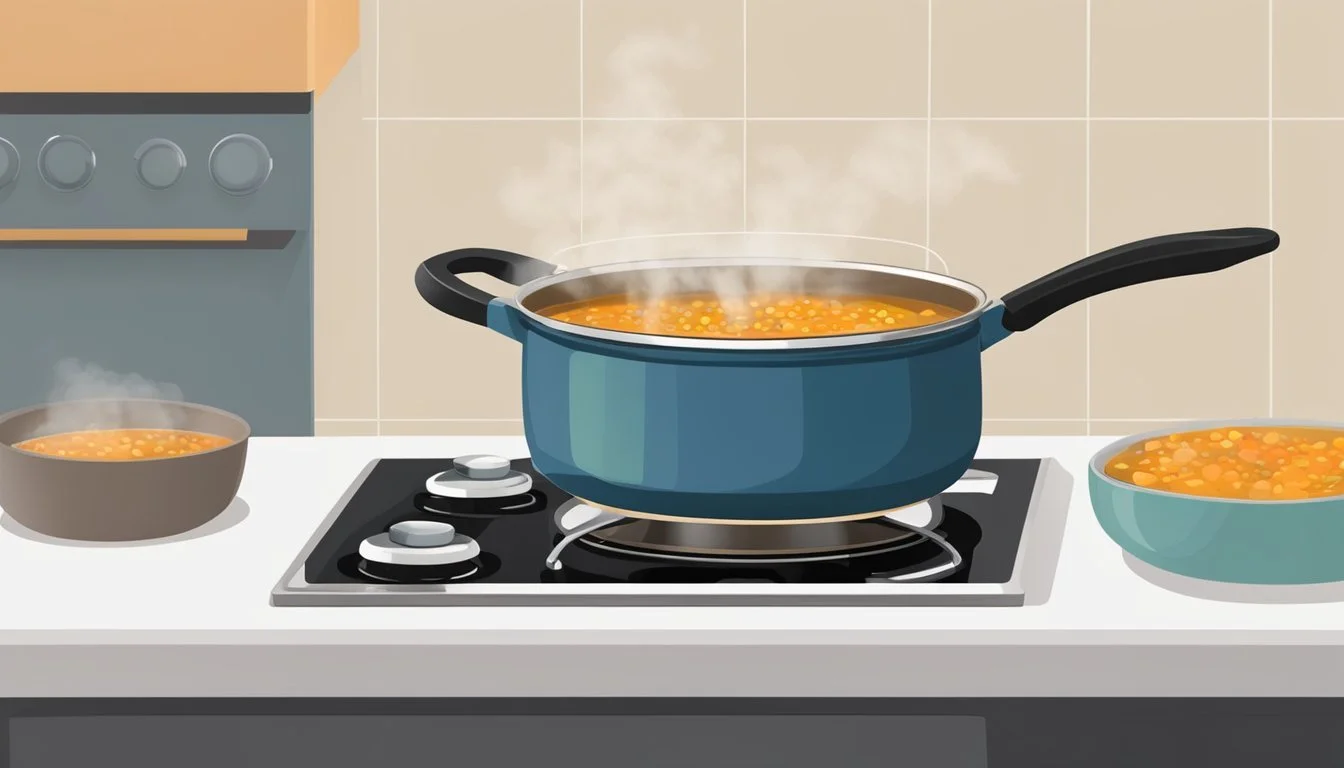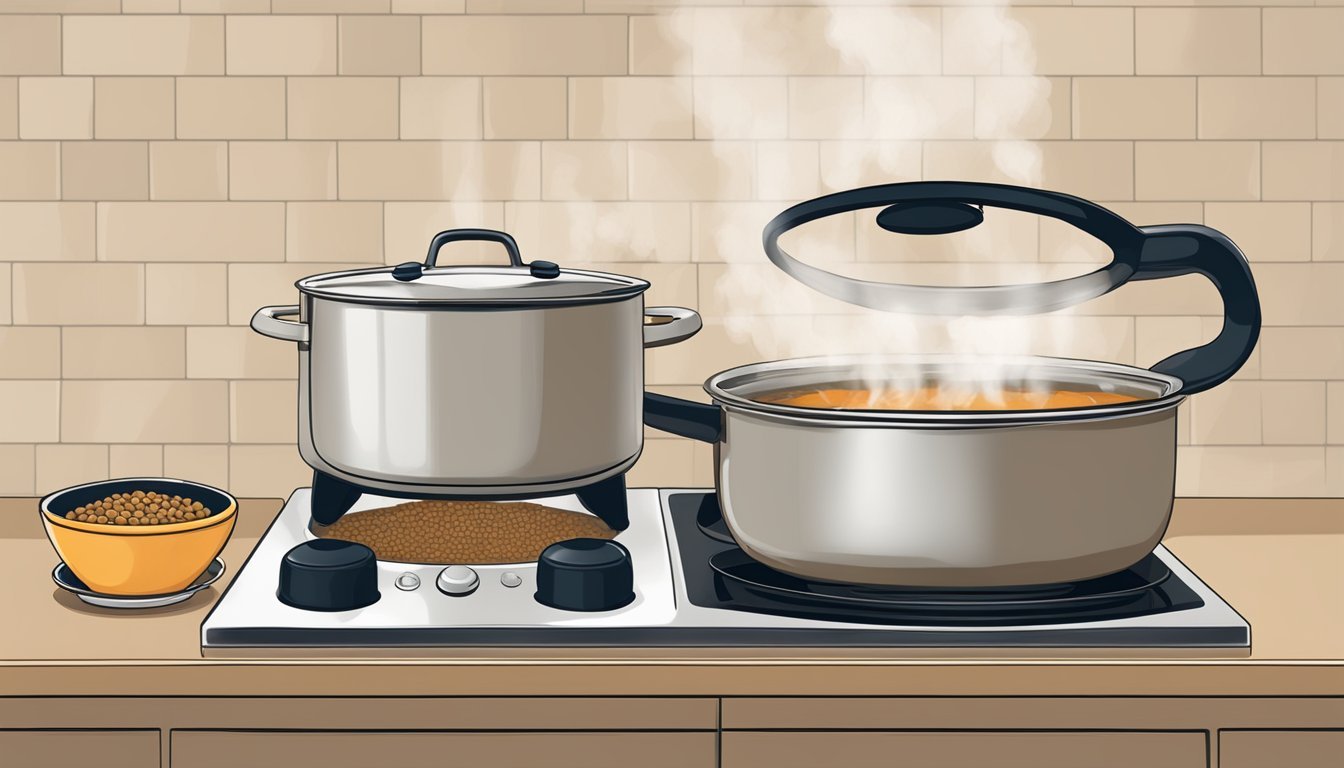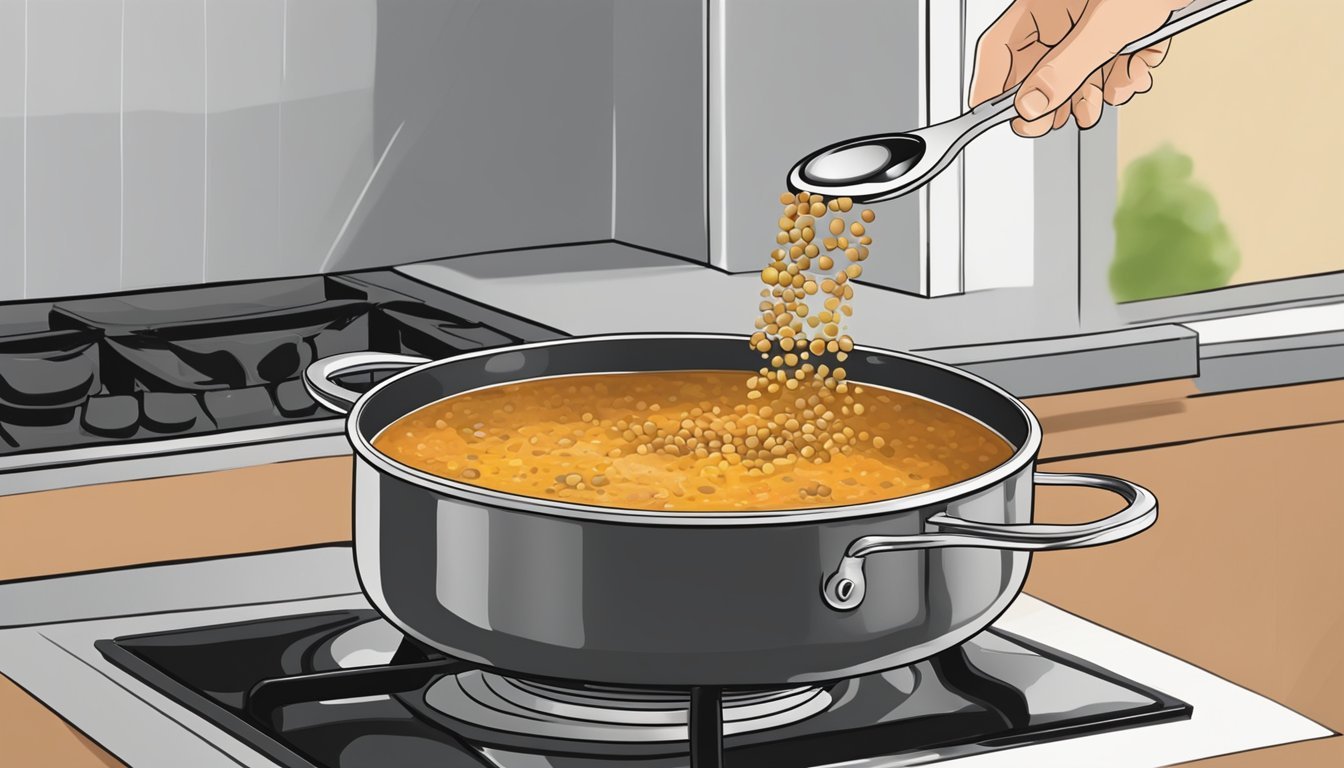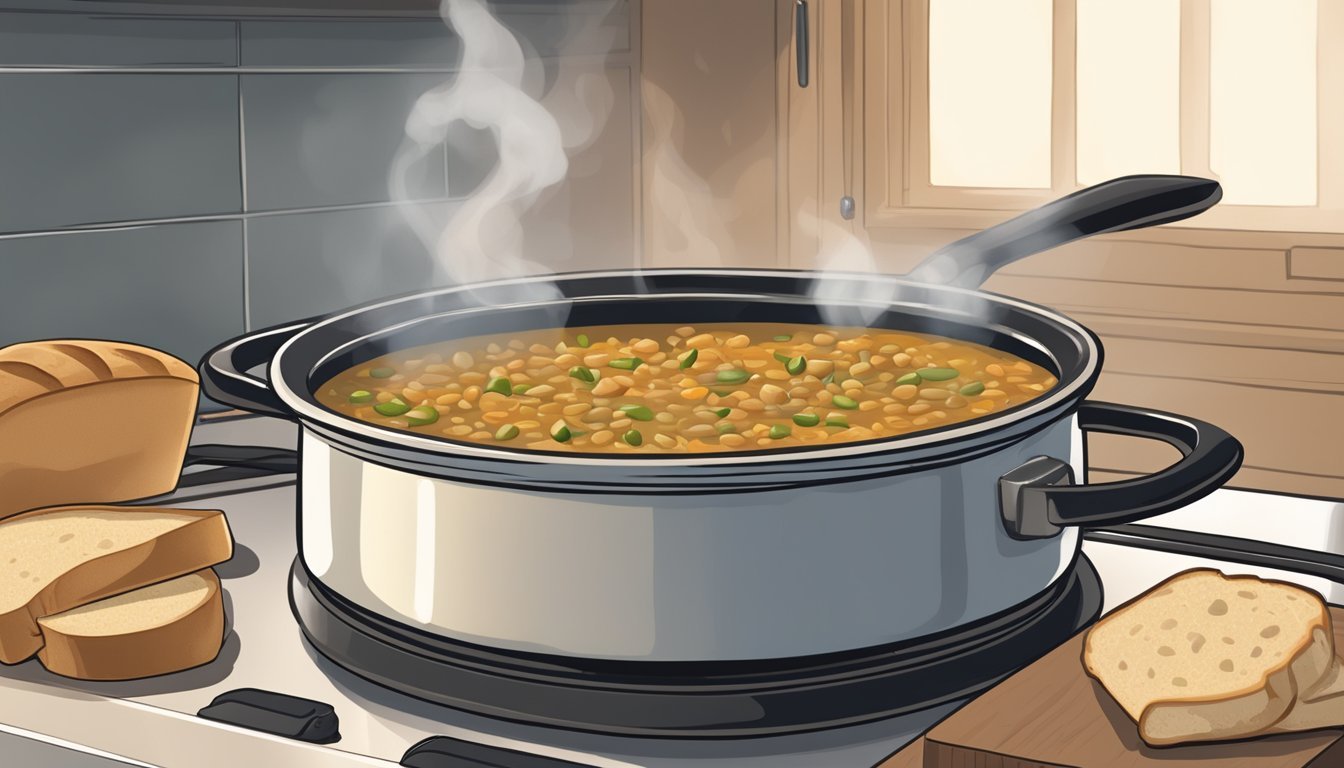Best Way to Reheat Lentil Soup
Keeping Consistency Perfect
Reheating lentil soup effectively without causing it to become overly thick hinges on proper technique and attention to detail. Lentil soup, with its rich blend of legumes, vegetables, and broth, offers a fulfilling meal that can be easily stored and reheated for later consumption. However, as lentil soup cools, the starches from the lentils can continue to absorb liquid, often resulting in a consistency that is too thick upon reheating. It is essential for enthusiasts and home cooks alike to understand how to restore the soup to its original viscosity without compromising its flavor and nutritional value.
Maintaining a consistent texture in reheated lentil soup starts with the initial cooking process. Recipes should be adjusted accordingly to accommodate for the thickening that occurs during cooling and reheating. When it's time to reheat, adding a small amount of water or broth can help recover the desired soup consistency. Moreover, the method employed to reheat the soup is just as crucial. Utilizing gentler reheating methods, such as a stovetop on medium heat or a microwave at medium power, can help prevent the soup from thickening excessively while also ensuring it is heated evenly.
One should be cautious not to rush the reheating process, as a gradual increase in temperature allows for better control over the soup's thickness. It's advisable to stir the soup periodically during reheating to ensure even heat distribution and to prevent the bottom from sticking to the pan. If the soup does thicken more than desired, additional liquid can be stirred in incrementally, tasting as one goes to ensure the seasoning remains balanced. Through these careful considerations, lentil soup can be reheated to a consistency and flavor that is as satisfying as when it was first prepared.
Understanding Soup Reheating Essentials
When reheating lentil soup, it's crucial to maintain its consistency and flavor. Key considerations include the soup's composition and the effects of heat on its various ingredients.
Soup Composition and Properties
Lentil soup typically consists of a water- or broth-based liquid, containing vegetables, lentils, possibly meat, and a blend of spices, herbs, and seasoning. Its viscosity is a balance between the broth's fluidity and the starches released from lentils and other ingredients. Here's a simplified breakdown:
Liquids: Water or broth, key for determining soup's thickness.
Vegetables: Provide texture and flavor; can become mushy if overcooked.
Lentils: Main protein source, absorb liquid and thicken soup as they cook.
Meat (if included): Should be tender without falling apart.
Spices and Herbs: Integral for aroma and taste; delicate herbs are added at the end of cooking to preserve flavor.
Fats: Enhance mouthfeel and carry flavors.
Effects of Heat on Soup Ingredients
Applying heat to lentil soup should be done gently and evenly. High or uneven heat can lead to overcooking the vegetables and lentils, leading to a mushy texture and loss of vibrant color. Proteins such as meat can become tough and unpalatable. Spices and herbs might lose their aromatic qualities if subjected to high temperatures for extended periods.
Heat: Low and slow reheating preserves soup consistency and prevents overcooking.
Stirring: Essential for even heat distribution; helps maintain an even texture without over-thickening.
Consistency: Controlled by managing heat; avoid boiling to prevent breaking down ingredients excessively.
Salt: May need adjustment after reheating as flavors can concentrate.
One should always reheat lentil soup with attention to these details to ensure a result that is as close to the original batch's taste and texture as possible.
Preparing to Reheat Lentil Soup
When reheating lentil soup, maintaining the desired consistency without over-thickening requires attention to the soup’s initial state and understanding the factors that contribute to thickening.
Reasons for Over-Thickening
The tendency for lentil soup to thicken excessively during reheating often stems from the natural starches present in lentils and other components like vegetables and beans. As these ingredients cool, their starches release into the broth, increasing the thickness. Additional thickening agents, such as flour, employed during the initial cooking process may compound the effect. An understanding of these factors is essential to prevent the lentil soup from becoming overly dense.
Initial Assessment and Prep
One's first step should involve assessing the soup’s consistency before reheating. If the soup has thickened considerably, they may want to thin it out by adding some water or broth. The amount of liquid should be proportional to the desired thickness; one can use spoons or a ladle to add the liquid gradually and stir well. It is crucial that they uniformly distribute any vegetables or lentils that may have settled at the bottom to ensure even reheating and to prevent scorching.
Preparation Checklist Check soup for initial thickness Decide if additional liquid is needed Gently redistribute solid ingredients Ready spoons or ladles for stirring
A careful initial assessment and methodical preparation are key steps to reheat lentil soup to the perfect consistency.
Reheating Techniques
When reheating lentil soup, maintaining its flavor and consistency is crucial. The following methods prioritize even heating and preventing the soup from becoming too thick.
Stove-top Reheating
For stove-top reheating, one should pour the lentil soup into a saucepan and place it over medium heat. It's important to stir the soup occasionally with a spoon, which ensures even heat distribution and prevents sticking. As the soup warms, one may need to adjust the temperature to avoid boiling; gentle simmering is preferable to retain the soup's broth and flavor.
Microwave Reheating
Using the microwave for reheating involves transferring the lentil soup into a microwave-safe bowl. One should cover the bowl with a lid or plate suitable for microwave use, which helps to trap steam and promote even reheating. Heat the soup on medium power for two-minute intervals, stirring between each interval to maintain the soup's consistency.
Oven Reheating
Lastly, oven reheating is a gentle approach, ideal for large quantities. Preheat the oven to a low temperature, approximately 350°F (175°C), and place the lentil soup in an oven-safe dish. Cover the dish with foil to prevent the soup from drying out and to retain moisture. Heat the soup until it is thoroughly warmed through, which could take from 10 to 30 minutes depending on quantity, stirring occasionally to ensure no over-thickening.
Adjusting Soup Consistency
When reheating lentil soup, maintaining the desired consistency is crucial. It's important to address over-thickening and ensure the soup returns to a pleasing texture without becoming too thin.
Thinning Over-Thickened Soup
If a lentil soup has become too thick upon reheating, a chef can gradually add broth or water to thin it. They should add the liquid in small amounts, stirring continuously, until the desired consistency is achieved. This method is preferred as it allows for careful control over the soup's thickness.
Broth: Incorporate warm broth to maintain flavor.
Water: Use cold water sparingly, as it can dilute the soup's flavor.
Avoiding Further Thickening
To prevent the soup from thickening further during the reheating process, one must be cautious not to apply too much heat. Additionally, if a roux or cornstarch was used to initially thicken the soup, reheating should be done gently to avoid activating these thickening agents again.
Roux and Cornstarch: Be mindful that these can thicken further when reheated.
Low Heat: Reheat the soup on a low setting, stirring frequently to prevent the base from congealing.
Consistency is managed through a balance of temperature control and the judicious addition of liquids. Monitoring and adjusting as the soup reheats are the keys to preserving its texture and flavor.
Soup Enhancement Strategies
When reheating lentil soup, one can both preserve and enhance flavors and textures through careful seasoning adjustments and the introduction of additional ingredients. The goal is to revitalize the soup to taste as fresh as when it was first made.
Seasoning Adjustments
Salt: Essential for balancing the flavors, but should be added sparingly to avoid over-salting as the soup reduces and flavors concentrate.
Spices: Warm spices like cumin or curry powder can enhance the underlying flavors of the lentil soup. A pinch of spices stirred in during reheating helps boost both taste and aroma.
Acidity: A splash of vinegar or a squeeze of citrus can brighten the soup, offsetting the heaviness of the lentils and complementing the earthy tones.
Herbs: Fresh herbs (how long do fresh herbs last?) such as cilantro or parsley bring a burst of freshness when added just before serving.
Additional Ingredients
Vegetables: Carrots, onions, and potatoes can be sautéed separately and added to the soup for an extra layer of flavor and a contrasting texture.
Tomatoes: Chopped fresh tomatoes or a spoonful of tomato paste can introduce a pleasant sour note that pairs well with the natural sweetness of carrots and onions.
By strategically incorporating fresh seasonings and vibrant ingredients, one can uplift the reheated lentil soup to a comforting dish that feels newly crafted.
Finishing Touches and Presentation
Once the lentil soup is reheated to the perfect temperature, a chef's final act is to ensure the presentation and finishing touches enhance the dining experience. They know that the aesthetic appeal is nearly as important as taste.
Firstly, chefs recommend selecting the right bowl that complements the soup's rustic charm. A warmed, wide-brimmed bowl not only retains the heat but also provides ample space for garnishing. They typically ladle the soup gently into the bowl, preserving its hearty texture.
Garnishes play a pivotal role in both flavor and presentation. A sprinkle of fresh herbs, such as parsley or coriander, adds a pop of color and an aroma that invites the diner to savor the soup. A dollop of crème fraîche or a drizzle of high-quality olive oil can introduce a silky contrast to the hearty lentils.
For pairing, chefs may recommend a slice of crusty bread or a light salad, ensuring that the accompaniments don’t overshadow the soup's earthy flavor profile.
When it comes to the aroma, an expert knows the importance of serving the soup immediately after reheating to capture the essence of its ingredients. They might finish with a quick grind of pepper or a sprinkle of exotic spices that wafts up and entices the senses.
A well-presented lentil soup not only satisfies hunger but also makes a lasting impression on the palette, combining warmth, taste, and visual delight in one bowl.
Storage and Preservation
Proper storage techniques are crucial for maintaining the quality and safety of lentil soup. Whether it is freshly made or a prepared variety, understanding the right methods for refrigeration and freezing can make all the difference. The following provides specific guidelines for storing lentil soup and reheating it to preserve its consistency and flavor.
Best Practices for Storing Lentil Soup
One should always allow lentil soup to cool to room temperature before storage. Rapid cooling can be achieved using an ice bath. Then, the soup should be transferred into airtight containers or heavy-duty freezer bags, ensuring all air is removed to avoid freezer burn. In the refrigerator, lentil soup will be at its best quality for 3 to 5 days. For long-term storage, it can be frozen where it maintains good quality for up to 3 months.
To preserve a variety of lentil soup, especially those containing meat or a meat-based stock, one must ensure quick cooling followed by prompt refrigeration. This mitigates the risk of bacterial growth. When refrigerating, liquids may separate or thicken upon cooling, so it's advisable to leave room in the container for liquid food expansion as it cools.
Storage Summary:
Cooling: Room temperature → Ice bath → Refrigeration
Refrigeration: Airtight container, up to 5 days
Freezing: Airtight container/freezer bag, up to 3 months
Reheating Previously Frozen Soup
When it comes time to reheat previously frozen lentil soup, the key is gradual defrosting for optimal texture and flavor. Thaw the soup in the refrigerator overnight, which gently restores it to a liquid state without compromising its structure. For reheating, one should do so slowly on the stovetop or in the microwave, stirring occasionally to ensure even heating. The soup should be heated until it reaches a boiling point to guarantee safety and palatability.
Whether the soup is meat-based or strictly vegetarian, slow reheating helps prevent over-thickening. If the soup appears too thick upon reheating, additional stock or water can be stirred in incrementally until the desired consistency is achieved.
Reheating Summary:
Defrosting: Thaw in refrigerator overnight
Reheating: Stovetop or microwave, stir occasionally, heat until boiling
Alternative Uses for Leftover Lentil Soup
Leftover lentil soup offers versatility in the kitchen. Rather than simply reheating the soup, individuals can repurpose the soup into various dishes to prevent food waste and add a nutritious boost. The lentil base lends itself well to an array of recipes, complementing different flavor profiles and textures.
Transforming Soup into a Stew: To thicken lentil soup into a hearty stew, one might add chunky vegetables like potatoes or carrots, or even grains such as barley or quinoa. The addition of these ingredients will absorb some of the liquid, resulting in a thicker and more filling dish.
Creative Soup Fusions:
Mulligatawny Soup: Enhance the lentil soup by incorporating spices like turmeric and cumin, along with coconut milk, to achieve the distinctive flavor of Mulligatawny soup.
Split Pea Blend: Combine with split peas for an added variety of legumes, enriching the soup with a different texture and flavor profile.
Ingredients for Other Recipes: Lentil soup can also be repurposed as a base for more complex dishes.
Casserole Filling: The soup can serve as a nourishing layer in a casserole, adding depth and protein.
Sauce Substitute: Reduce the soup to thicken it and use as a sauce over pasta or rice, incorporating complementary spices and herbs as needed.
In summary, leftover lentil soup should not be underestimated. Its adaptability can enhance a range of recipes from stews to casseroles, providing both a nutritious element and a platform for culinary creativity.
Tips and Tricks for Mastering Soup Reheating
Reheating lentil soup, or any soup for that matter, can be an art in itself. Here are some strategies to make sure the soup warms evenly without over-thickening:
Gentle Heat
Start with a medium heat setting.
Allow the soup to warm slowly to prevent the lentils from becoming mushy.
Consistent Stirring
Stir occasionally to distribute heat evenly.
This method prevents the bottom from scorching and the lentils from sticking.
Microwave Method
For a quick reheat, use a microwave.
Heat the soup in short intervals, stirring between each to ensure even warmth.
Dilution Solution
If the soup has over-thickened, thin it out with a little broth or water.
Add the liquid gradually, mixing well to maintain the soup’s flavor profile.
Avoid Boiling
Simmer the soup instead of boiling.
Boiling can break down the texture of lentils and can over-thicken the soup.
Proper Storage
Cool the soup completely before storing.
Place in airtight containers to maintain the soup's quality for reheating.
By following these techniques, the integrity of soup recipes can be preserved throughout the cooking process. By doing so, one ensures the reheated soup retains the taste and texture closely resembling the freshly made dish.











